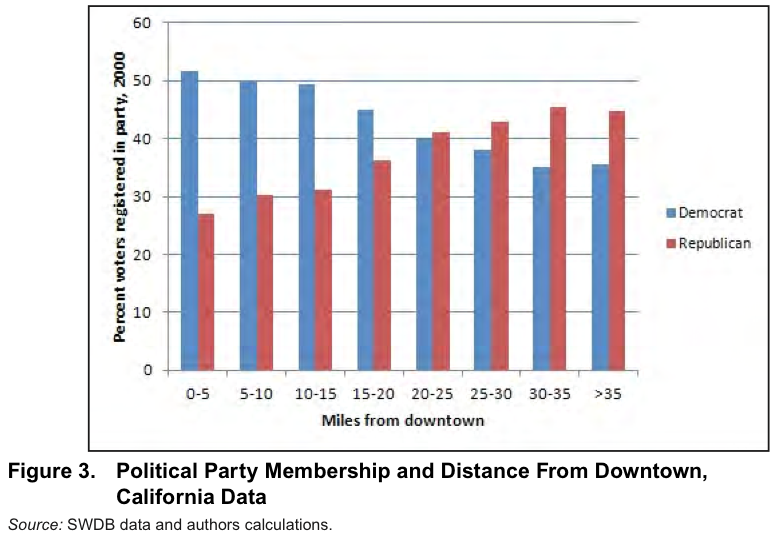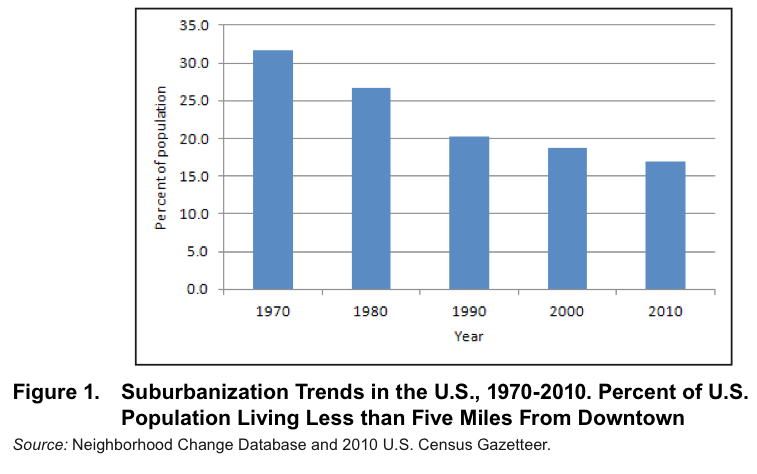MINETA TRANSPORTATION INSTITUTE
Introduction
Public transit investment represents a key strategy for revitalizing center cities and reducing the harmful effects of driving on the environment. However, enacting transit projects often requires approval of the median voter – that is, that at least 50% of the electorate plus one, the median voter – vote to approve. However, in the United States and other countries, the median voter has been suburbanizing, and few suburbanites rely on public transit systems. This study explores the association between suburbanization and political support for transit investment.
 There are three broad explanations for why suburban voters may tend to oppose public transit investment. First is an access hypothesis. Relative to center city residents, suburbanites face a higher time cost of accessing such public transit and thus will be less likely to use it and thus gain fewer benefits from its presence. Given that public transit tends to improve access to the center city, suburbanites who also work in the suburbs will gain less from such infrastructure, and our results document the magnitude of the phenomenon. We refer to this as a “price” effect of suburbanization. A second explanation for why urbanites are more likely to support transit investment is a capitalization hypothesis. Landowners in center cities will enjoy a windfall in land values when new place-based investments are made close to their homes. A third hypothesis for explaining differential center city versus suburban support for transit projects relates to residential self-selection. If liberals tend to live in center cities and to support public projects, while conservatives tend to live in suburbs and to oppose high taxes and high cost projects, then we will observe a center city/suburban differential even in the absence of the price and investment effects detailed above. In the results we present below, we engage in several econometric strategies to address this possibility.
There are three broad explanations for why suburban voters may tend to oppose public transit investment. First is an access hypothesis. Relative to center city residents, suburbanites face a higher time cost of accessing such public transit and thus will be less likely to use it and thus gain fewer benefits from its presence. Given that public transit tends to improve access to the center city, suburbanites who also work in the suburbs will gain less from such infrastructure, and our results document the magnitude of the phenomenon. We refer to this as a “price” effect of suburbanization. A second explanation for why urbanites are more likely to support transit investment is a capitalization hypothesis. Landowners in center cities will enjoy a windfall in land values when new place-based investments are made close to their homes. A third hypothesis for explaining differential center city versus suburban support for transit projects relates to residential self-selection. If liberals tend to live in center cities and to support public projects, while conservatives tend to live in suburbs and to oppose high taxes and high cost projects, then we will observe a center city/suburban differential even in the absence of the price and investment effects detailed above. In the results we present below, we engage in several econometric strategies to address this possibility.
Over the last two decades, a large number of important transportation-related ballot measures have been voted on in California. A review of all ballot propositions from 1990 to present revealed 20 had a significant transportation component. This study uses various data sets to investigate the transit priorities that Californians revealed in individual-level surveys and in binding voting initiatives. Leveraging both survey and voting data provides the opportunity to test the validity of our estimate. If policy makers are basing decisions on the results from surveys of public opinion, it is important to know how accurately the survey responses predict actual voting.
Specifically, we test hypotheses concerning the role of household demographics, including age, education and race, urban form attributes, including density, centrality and homeownership status, ideology, and socio-economic variables, including income and unemployment status.
The analysis of 20 propositions spanning two decades documents important characteristics of elections and the electorate. Policy makers can use our results to predict how voters in certain precincts are likely to vote on various types of transportation-related propositions.
This report begins by providing background information, including documenting suburbanization trends in the United States and California, reviews related literature, discusses the ballot initiative process in California, and lays out the study’s methodological approach.
Chapter II analyzes three case studies; two recent and one historical: the High-Speed Rail proposition (Proposition 1A) from 2008, the Global Warming Solutions Act moratorium proposition (Proposition 23) from 2010, and the Passenger Rail and Clean Air Bond Act (Proposition 181) from 1994, an important example of a transportation funding attempt from an earlier time period.
Suburbanization appears to have reduced support for High-Speed Rail (HSR). HSR offers the greatest benefits to urbanites that can more easily access them. Our results are consistent with this prediction; in Central Valley areas, homeowners near future HSR stations were more likely to vote “yes” on Prop. 1A than homeowners far from future HSR stations. We refer to this as an “investment” effect of suburbanization. Our findings are thus consistent with increasing suburbanization reducing support for transit through both “price” and “investment” effects.
The next case study is Prop. 23 from 2010. This proposition only gathered 38.4% of the vote and would have suspended California’s Global Warming Solutions Act (AB 32). Here again, suburbanization should affect voting on this proposition, as the burden of the regulations that results from AB 32 are borne disproportionately by residents with a large carbon footprint—and previous literature has found that suburbanites have larger footprints.2 The results are consistent with this “price” effect; even though the benefits of climate change mitigation are a global public good, suburban voters were more likely to support Prop. 23, all else being equal.
We also find support for the “investment” effect, as homeownership may increase or decrease the probability of support for transit environmental policies, depending on how far the voting precinct is from downtown. Homeownership leads to greater support for climate change mitigation in urban areas, but homeownership leads to less support for these efforts in suburban areas. These results are perfectly consistent with predictions from urban economic theory regarding how gas taxes and other policies that increase the cost of transportation differentially affect urban versus suburban land markets.
We present a third detailed case study mainly for historical comparison; analysis of the rail transit bond initiative – Proposition 181 from 1994 – indicates that some but not all of our findings are robust across multiple issues and time periods. While we find evidence of the price effects of suburbanization that we describe above, results concerning investment effects were inconsistent with results from the more recent time periods. In California, the early 1990s was an interesting time from a transit funding perspective, and as we discuss in the conclusion, should be studied in more detail in future work.
In sum, the three case studies generate new knowledge about voter preferences for public investment in public transit and environmental regulation. Also, by documenting the correlates of support for all transit-related propositions from 1990 to 2010, this study will serve as a valuable reference for future research.
Finally, considering the central role of land value in our theoretical model, we end this report with some thoughts on the possible role of tax increment financing, value capture and other ways of leveraging land markets to finance public transit infrastructure. Creative financing mechanisms hold the promise of increasing the amount of capital available for transit, and also of ensuring that scarce transit investment funds are used for the highest- value projects.
The remainder of this Introduction contains five subsections that: document suburbanization trends in the United States and California, review related literature, discusses the ballot initiative process in California, lay out the study’s central hypotheses, and explain the study’s methodological approach. This is followed by the three case studies. Then, we present statistical results for all 20 propositions from 1990-2010. The Conclusion summarizes the findings, highlights limitations of this study, and discusses the possibility of creatively leveraging land markets to generate investment funds for public transit investment.
Suburbanization Trends
In each decade from 1970 to 2010, for the entire United States, we calculate the share of metropolitan area residents who live a fixed interval distance from the central business district (CBD) (e.g., 0-5 miles, 5-10, 10-15, 15-20, etc.). We use tract-level data from the Neighborhood Change database for the 1970-2000 period, and tract-level data from the U.S. Census Gazetteer for 2010.
Read full report (PDF) here: California Voting and Suburbanization Patterns
About Mineta Transportation Institute
transweb.sjsu.edu
“The Mineta Transportation Institute (MTI) conducts research, education, and information and technology transfer, focusing on multimodal surface transportation policy and management issues. It was established by Congress in 1991 as part of the Intermodal Surface Transportation Efficiency Act (ISTEA) and was reauthorized under TEA-21 and again under SAFETEA-LU. The Institute is funded by Congress through the US Department of Transportation’s (DOT) Research and Innovative Technology Administration, by the California Legislature through the Department of Transportation (Caltrans), and by other public and private grants and donations, including grants from the US Department of Homeland Security. DOT selected MTI as a National Center of Excellence following competitions in 2002 and 2006. The internationally respected members of the MTI Board of Trustees represent all major surface transportation modes. MTI’s focus on policy and management resulted from the Board’s assessment of the transportation industry’s unmet needs. That led directly to choosing the José State University College of Business as the Institute’s home.”
Tags: California Voting, Implications, Mineta Transportation Institute, Suburbanization Patterns, Transit Policy







 RSS Feed
RSS Feed